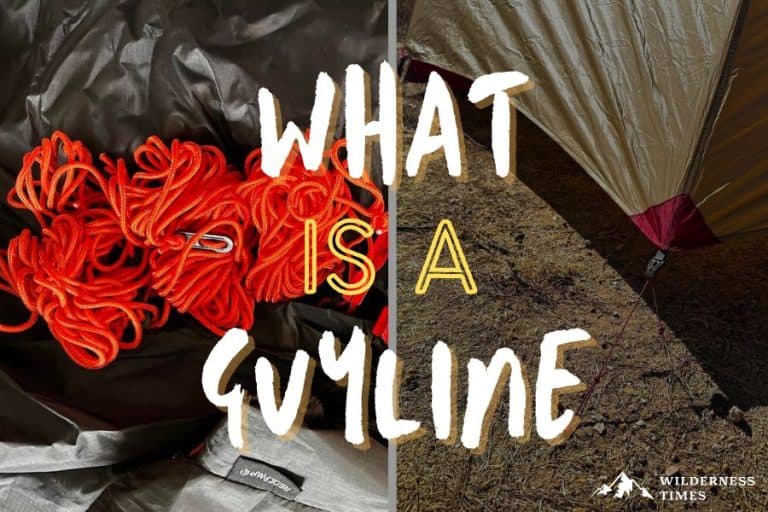You’ve gotten to camp and started to set up your gear when a few ropes fall out of your tent sack. What the heck are those? Guylines!
Guylines are ropes or cords that attach to your tent or rain fly and help stabilize the structure by anchoring it to the ground.
Because they pull on your tent, they keep the structure taut and secure.
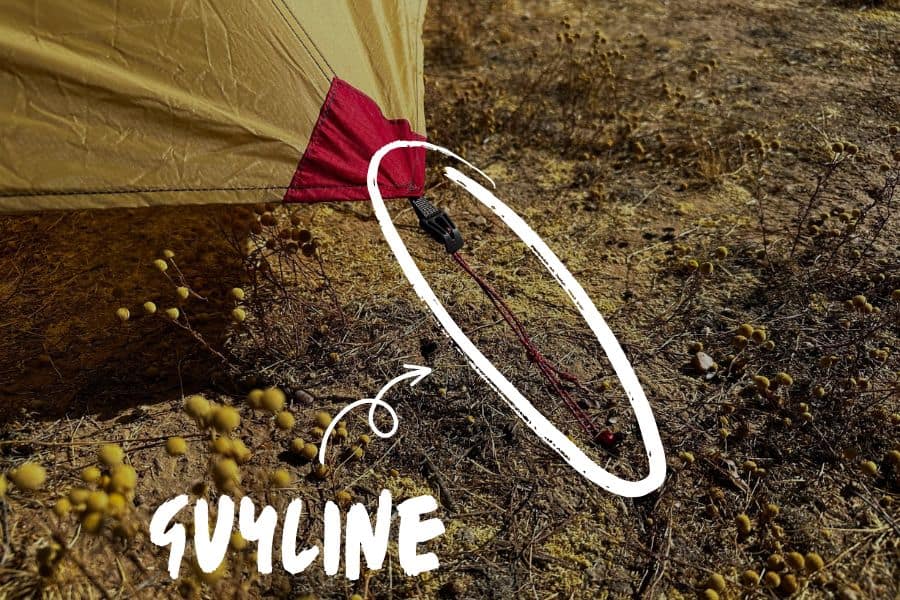
The Importance Of Guylines In Camping
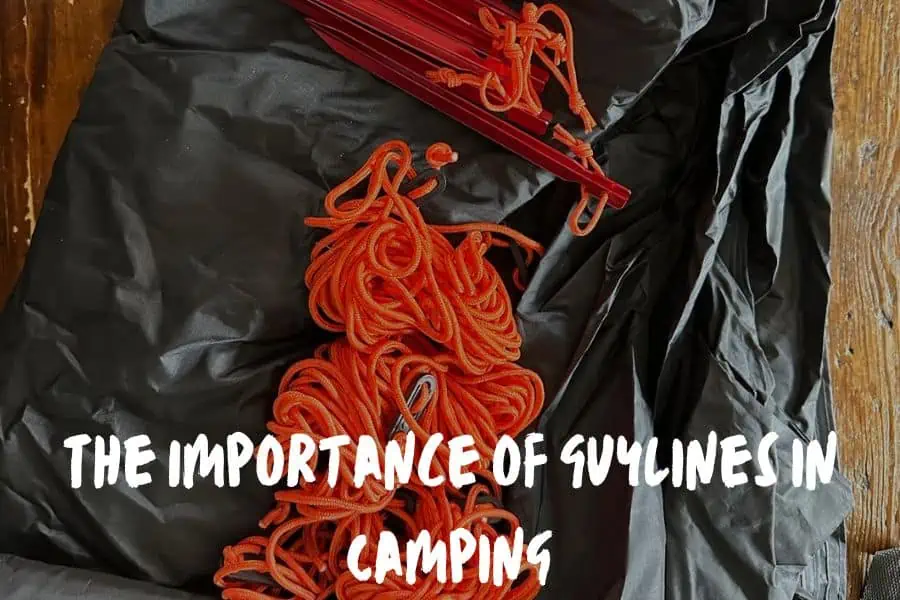
Guylines are a necessary part of your tent structure because they add stability to your tent experience.
At their core, guylines tie your tent to the ground, so they’re great for keeping your tent stable, especially during high wind or unfortunate weather conditions.
Additionally, because guylines connect from your tent to the ground, they also keep your tent taut, maximizing the headspace and overall structure of your tent.
Overall, guylines help keep your tent, and the people inside it, safe and secure.
How To Set Up Guylines For Camping
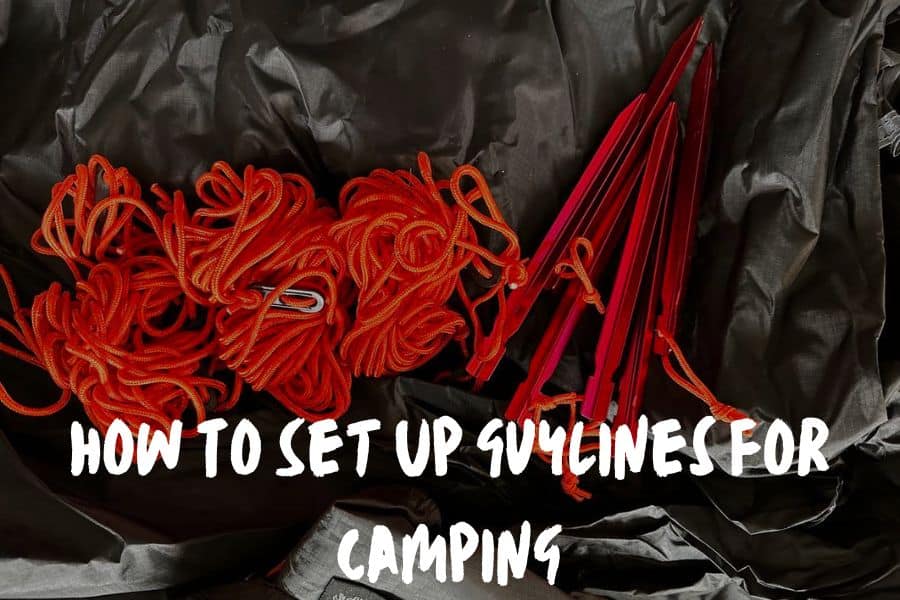
Most tents include guylines in their design. In general, guylines attach to loops on the edges of your tent or rain fly structure and connect with ground stakes a few feet from the base of your tent.
There are two knots you’ll need when setting up your guylines: the half-hitch and the taut-line hitch. We’ll go over when you’ll use each one in the instructions below.
Step 1: Find The Correct Placement For Your Guylines
First, you’ll need to find the correct placement of the guylines for your tent design.
Generally, this is denoted on the tent setup instructions. You’ll need to look for loops on the edges of your tent and rain fly.
In general, you can expect at least two guyline loops on the rain fly near the entrance of the tent, and at least one or two loops on the back of the tent.
However, these numbers can increase depending on the size and model of the tent.
The loops on the front will help you set up your entrance vestibule, while the loops in the back will lend you added stability.
Step 2: Attach Your Guylines To The Tent
When I’m setting up my guylines, I use the half-hitch to attach my cord to the tent or rain fly loop.
This knot is super stable and will keep your guylines firmly connected to your tent.
Step 3: Attach Your Guylines To The Stakes
Once you have your guylines attached to your tent, you need to tie it to your stake.
For this knot, I use the taut-line hitch. This knot is one of my favorites because it’s adjustable, which will come in handy in our final step:
Pro-tip: For this knot, it can be helpful to have the stake pushed into the ground and a bit of slack in the cord. However, this is not the final placement of your stake. We’ll re-stake for added stability in the next step.
Step 4: Find Solid Ground For Your Stakes
Your guyline is attached to your stake with the best taut-line hitch you’ve ever seen. Now what? It’s time for the final staking!
With your guyline attached to your stake, find a piece of solid ground about three feet away from the base of your tent.
From there, you’ll push the stake into the ground at a 45° angle away from the tent.
If your stake has a hook at the top, make sure that the open portion of the hook is pointed toward the ground during this step.
Step 5: Get Rid Of Extra Slack
Remember that taut-line hitch? It’s time for its moment of glory!
With everything tied and in the correct positions, slide that knot up your cord to get rid of any leftover slack on the line.
The goal here is to create as much tension as we can on the guyline. The more tension, the more stability the guylines are giving the tent structure.
Common Mistakes When Using Guylines
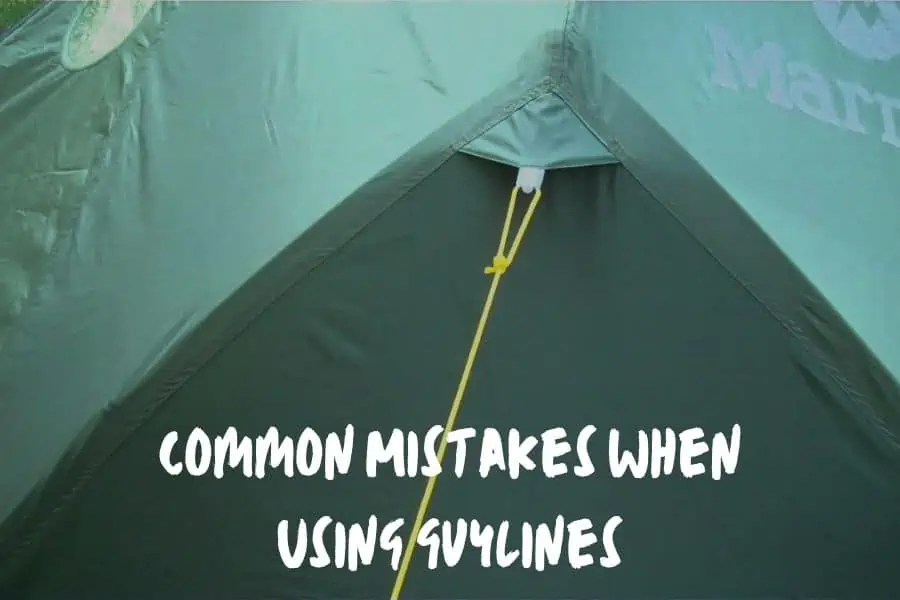
Incorrect Guyline Length
It’s important that your guyline is long enough to be pulled taut for a few feet to offer stability to your tent but not too long that the rope loses tension.
For most tents, this means your guylines should be around three feet long.
However, if you’re camping in a location with snow cover, you can use a guyline up to six feet long to reach through the snow to solid ground.
Improper Angle Of Guylines
When set up successfully, your guylines should be reaching out from your tent at roughly a 45° angle.
You’re most likely to find this angle if you’re staking your guylines around two to three feet from the base of your tent.
Improper angles in your line result from staking your guylines either too close or too far away from your tent, which can compromise the stability and safety of your tent experience.
Neglecting To Use All Guyline Points
Where guylines attach to your tent will depend on the specific model you’re using.
However, because the guylines have been specifically designed for the tent you’re using, it’s important to follow instructions and use them where they’re recommended.
Following instructions will be helpful for multiple reasons here. First, the structure will stand as intended and designed, meaning you’ll get the best tent experience possible.
Second, connecting the guylines at the correct points will ensure that your structure is safely and securely set up.
The last thing you want is your tent blowing away in the wind or taking in water from a rainstorm.
Setting up all your guylines where recommended will prevent any unfortunate, or unsafe, mistakes from occurring.
Also See: Camping in a Thunderstorm (How To Stay Safe)
Not Using Neon Or Reflective Guylines
When set up properly, your guylines will pull taut and connect to stakes a few feet away from your tent.
In other words, they become prime trip lines, especially during nighttime hours.
I recommend you pick guylines that are made from neon or reflective material.
This way, you’ll be sure to see them underfoot and reduce your chance of face-planting on your way in or out of your tent.
Not Practicing Your Knots
Nothing is worse than getting to camp at dusk and fumbling over unfamiliar knots as you’re losing daylight.
To save yourself the headache, make sure you practice the half hitch and taut-line hitch knots before you head out on your camping excursion.
Tips For Managing Guylines
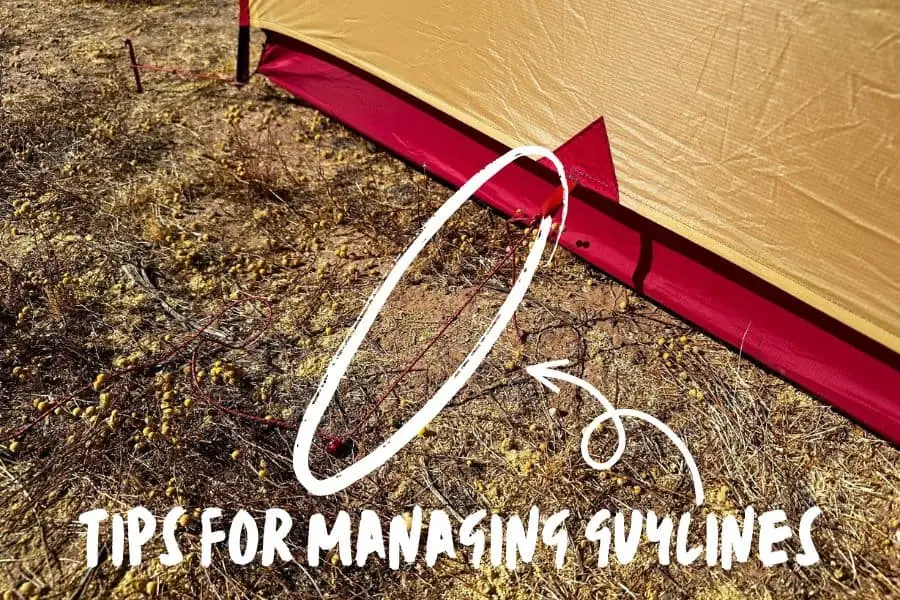
How To Prevent Guylines From Tangling
I recommend wrapping each guyline up individually in a coil and securing it around the middle.
I do this by wrapping the cord around my hand, using the last bit of length to create a few loops around the middle of the bundle, and slipping the end of the rope underneath the middle loops to secure.
Doing this with each individual guyline will make them less likely to unravel and get tangled with each other during storage.
Storing Guylines Properly
There are multiple ways to store your guylines to keep them untangled and in good shape. Most tents have a pocket you can use to store your guylines.
I generally tie them up (as described above) and store them in an interior pocket in my tent. However, you can also store them in your tent bag, or in your tent vestibule.
I highly recommend you store your guylines with your tent supplies so they don’t get lost or “repurposed” for another use on the next camping trip.
The Importance Of Regularly Checking Guylines
Old or worn guylines will be less likely to keep your tent secure on the trail.
Because of this, it’s important to regularly check your guylines for fraying or wear that could prevent them from holding tension during use.
If you see any signs of overuse or wear, make sure to replace your guylines before your next camping trip.
FAQs
How Do I Prevent My Guylines From Tangling?
The best way to prevent guylines from tangling after use is to bundle each one up individually before you store them.
I do this by wrapping each guyline up in a coil and securing it around the middle.
What’s The Best Material For Guylines?
The best guylines are made out of synthetic yarn, like polyester or polypropylene, which are both water-resistant and non-stretch materials.
Both of these materials will keep your guylines stable and secure, even in unfavorable weather conditions.
Additionally, when you’re looking for new guylines, look out for “braided ropes,” or ropes that use multiple strands of fabric weaved together for added stability.
What’s The Ideal Length For A Guyline?
The ideal length of your guyline will depend on weather conditions. In general, I recommend using three-foot cords for general use.
If you are camping in winter conditions, or in an area with snow, I recommend bringing six-foot cords with you.
In these cases, you’ll still want to stake the ground, so you’ll want the extra length to help you reach through various feet of snow cover.
Is There A Difference Between Reflective & Non-Reflective Guylines?
Functionally, there is no difference between reflective and non-reflective guylines. So, if you’re in a pinch, feel free to use darker colors or non-reflective cords for your tent setup.
However, I always recommend that you prioritize guylines made from brighter colors and/or reflective materials to increase visibility and prevent any potential tripping.
What Can I Use To Stabilize The Guylines If I Don’t Have Stakes Available?
Got to your campsite and realized you forgot your stakes? No worries, you can use surrounding trees, rocks, or other heavy objects around camp to secure your guylines at a 45° angle.
The important factor here is that the object you’re using to secure the guylines is stable and/or heavy, and can still get the guylines reliably taut to secure your tent.
In Summary
Guylines are the unsung heroes of any camping trip.
They are fundamental in adding stability to your tent experience and will help you stay safe and secure throughout your outdoor adventure.


